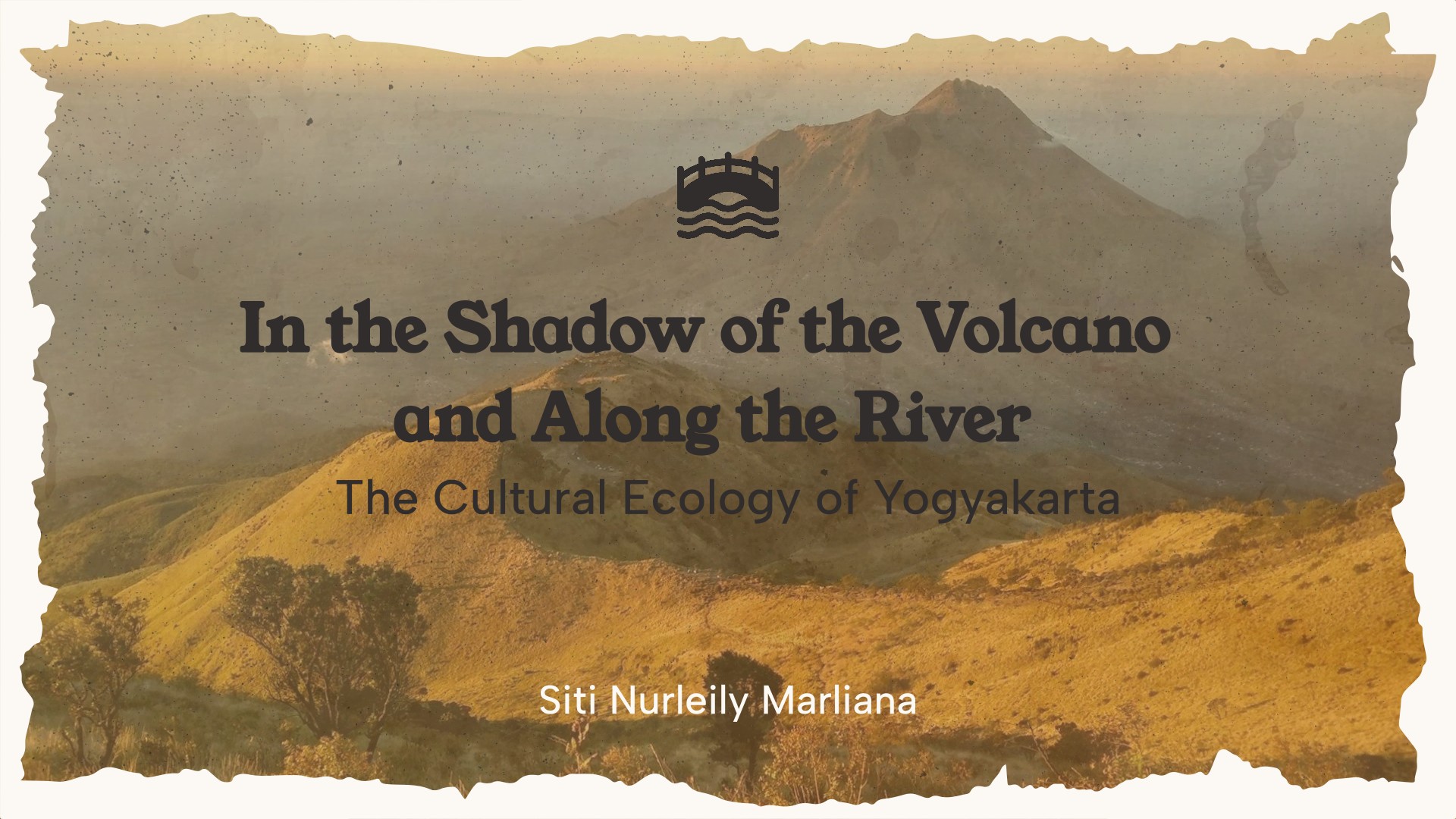In the Shadow of the Volcano and Along the River: The Cultural Ecology of Yogyakarta
This article originally accompanied the talk of the same name for the 2024 Summer School organized by the Department of History, Faculty of Cultural Sciences, Universitas Gadjah Mada, in collaboration with KITLV Leiden and WALHI. Learn more about it here.
The early states of Java developed in the shadows of volcanoes and along the riverine waters that flowed from them, cultivating a non-indigenous grain, rice (Oryza sativa L.), brought by Austronesian-speaking peoples thousands of years earlier. By the 9th century CE, central Javanese courts underwrote their monumental building campaigns—the costliest in the island’s history—with their long-term proximity to farming communities that produced substantial surpluses of this grain. Among these rice fields, we would have found a complex system of irrigation, itself surrounded by houses planted with trees and perennials, orchards, betel and taro gardens, and cotton fields, in pastures, forests, marshes, riverbanks, caves, and salterns. Tax charters from this period suggest that rice was not only the major subsistence crop in Java, it was a market commodity and the basis of the state’s agricultural tax systems, containing terminology we recognize today—sawah for irrigated rice fields, gagā for dry rice fields, and tgal for dry fields planted with other crops.

How could a grain originating in the Chinese highlands dominate the economies of Mataram Java? The proclivity of its expansion is rooted in a climate that favored its cultivation, featuring moderate monsoonal rains and mineral-rich soil replenished regularly by active volcanoes. Along Merapi and its sister volcanoes, rain clouds were trapped, watering their southern slopes and increasing the available surface water even throughout the drier months, and creating a relatively stable landscape, with moderate seasonal shifts, many small and medium-sized rivers fed by volcanic springs, and shallow inclines. Accordingly, Merapi is today one of the most densely populated volcanoes in the world.
Because of the fertility of land on volcanic slopes (and through the movement of water, the land below), farming communities have always clustered around them, concomitantly developing mythologies representative of the life and death they bring, linking them to spirits of their ancestors, and later to the features of gods. Surveys of central Java and Yogyakarta show that most early settlement was nearer to the volcanic plains than the coasts, at 50–400 m asl. Here, over 80% of sites lie within 500 m of at least one river. Early farming settlements consequently encircled the volcanoes, near where ample water flowed but away from the paths of potentially catastrophic lahar flows. Pollen samples from Borobudur indicate that by the 9th century, the region surrounding the monument was reasonably well-settled, and that the terrain supported a mixture of grain fields, house gardens, palm groves, and forest. Conversely, much of the land below 25 m appears to have been under swamp-forest or constituted uncultivated flood plain. The first parts of the landscape to be exploited thus seem to have been land with moderate groundwater potential, potentially including upland lakes, and less so the low-lying wet areas.
As the first millennium turned, historical records show Javanese rulers encouraging farming communities to shift away from dry rice to wet rice farming regimes, benefiting the former by anchoring the population in place, easing population counts and taxation, making harvests more predictable, and strengthening state security by “domesticating” key parts of the countryside. Grants issued during this time for land conversion were mostly on the fringes of settled territories, along major road and water connections, as far as Sumbing and Sindoro, where forested land was converted to protect the high road to the north.
Such conversion to irrigated cultivation, however, was labor-intensive, requiring collecting and distributing both the water and fertilizing silt to fields through a system of weirs and channels. States were also rarely in a position to actually enforce these changes. Rather, conversion to irrigated rice came from below, at the community level, stemming from natural drivers such as the increased fertility provided by irrigation, greater crop volume and predictability, and population increase, along with a combination of population increase, community ownership, and structural changes in patterns of land tenure. Besides facilitating much or most of the agricultural tax income, irrigated rice fields factored in the sale of land, often being cited as having been pawned or leased. Rice fields constituted the major capital holdings of farming families. Practical organization of irrigation, as such, was handled not by the state, or by individuals, but by communities, relegating the former to supporting larger works such as dams (which were carried out by religious communities) through religious benefice, and presenting them as religious rather than functional acts.
Through the subsequent centuries, kingdoms, sultanates, and colonial invasions, the Javanese landscape has continued to shape and be shaped by its inhabitants, and while it continues to provide for them, there are escalating consequences for working the land. Population pressure and agricultural intensification carve into Java’s slopes and strain its ability to provide ecosystem services. In the colder climes of the Dieng Mountains, farmers turn to potatoes, and move ever upward as the land loses productivity and natural disasters become a regularity. In Yogyakarta’s southern coast, rows of the sheoak Casuarina equisetifolia are planted to shield its dunes from wind, protect farmland, and provide shade for tourists. Meanwhile, even through the greatest tragedies, the Javanese peoples’ indelible connection to its volcanoes remains unbroken. In Merapi’s forbidden zones, residents resisted evacuation after its 2010 eruption, some of them framing their reluctance in metaphysical terms. In this way, we find that, as in the past, the humans who come to dwell on Java’s fertile soils may exploit it even to excess, but protecting the land and its flora and fauna inevitably starts with understanding how we are intrinsically linked to it.
Siti Nurleily Marliana and Joaquim Baeta